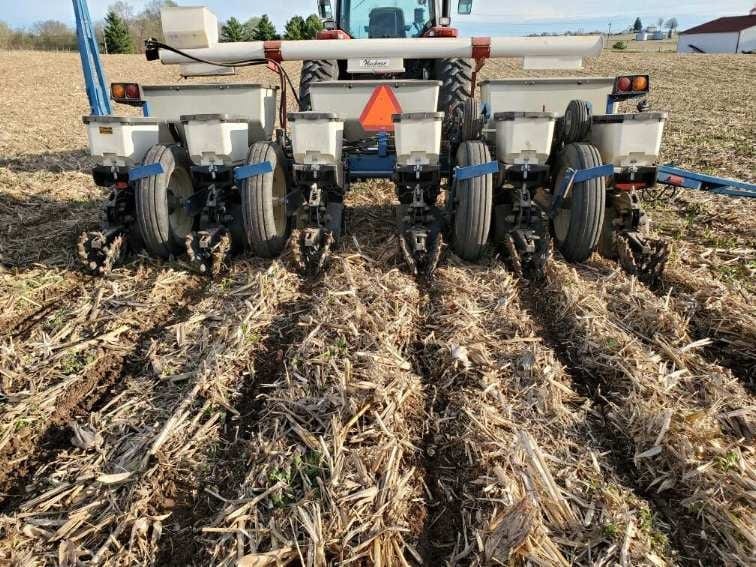 As June gets underway, I still need a couple more dry days to finish planting. The field conditions so far this season have been a little too wet and a little too cold – never just right. I have about 20 to 25% of my corn and soybean fields left to plant.
As June gets underway, I still need a couple more dry days to finish planting. The field conditions so far this season have been a little too wet and a little too cold – never just right. I have about 20 to 25% of my corn and soybean fields left to plant.
I am still adapting to tough field conditions. If I am not able to plant my remaining corn during the first few days of June, I will adjust my plans and plant those fields to soybeans.
 For example, one field intended to be planted with corn had deep ruts that had to be worked out with tillage. Although I avoid tilling as much as possible, wet weather last fall during harvest caused ruts and soil compaction that would hurt this year’s crop without working the soil. Plus, part of this field still has water standing on it. I will plant the portion that is dry to corn as soon as possible. But after the water drains away, I will plant soybeans in that section of the field instead of corn.
For example, one field intended to be planted with corn had deep ruts that had to be worked out with tillage. Although I avoid tilling as much as possible, wet weather last fall during harvest caused ruts and soil compaction that would hurt this year’s crop without working the soil. Plus, part of this field still has water standing on it. I will plant the portion that is dry to corn as soon as possible. But after the water drains away, I will plant soybeans in that section of the field instead of corn.
Another field is still too wet for me to terminate the cover crop before I plant it. I like cover crops, but they have been a challenge this season. Because of the weather, it hasn’t been an easy year to manage them. Cool temperatures and cloudy weather mean that even with cover crops pulling moisture out of the soil, fields like this one just aren’t drying out so that I can drive my equipment into them.

Once planting is finished, I will evaluate where I need to replant. The cool, wet weather caused the fields planted first to take a couple weeks to emerge. In fact, some soybean fields planted more recently emerged more quickly than early-planted soybeans. Fortunately, all my soybeans have emerged fairly well so far, even in areas that flooded after heavy rains in mid-May. However, some corn fields didn’t handle the water as well, and I will have to replant some areas. I can tell that the tiling I did early this spring helped these fields drain better than before.
We are finally getting some warmer weather, which means that crops planted in late May and early June will likely grow quickly and not be very far behind earlier planted fields in their development.
The warmer weather also means that it is time for me to make hay this season. Based on the weather, it looks like I will be trying to make hay, finish planting and replanting, and side-dressing corn with nitrogen all at the same time. To side-dress, I apply dry urea, a form of nitrogen with a stabilizer added to protect it from volatilization, by broadcasting it over the corn when it is 15 to 20 cm, or 6 to 8 inches, tall. Again, this will be a serious time management challenge.
 During May, I sold the last of my 2019 hay crop for the best prices I’ve ever received. That has been a bright spot in an unpredictable spring. And reminds me that I enjoy raising hay, despite the timing challenges.
During May, I sold the last of my 2019 hay crop for the best prices I’ve ever received. That has been a bright spot in an unpredictable spring. And reminds me that I enjoy raising hay, despite the timing challenges.
And the wild morel mushrooms have popped out of the ground. My efforts to teach my help to hunt these tasty delicacies have not been going as hoped.
Along with difficult weather, farmers like me continue to face market challenges. The U.S. government is developing programs to help farmers manage low prices caused by the COVID-19 pandemic. But I applied to a couple different programs for assistance and didn’t qualify to participate. Some assistance for the 2020 season will be based on a percentage of 2019 yields, but for farmers that were not able to plant some fields last year due to flooding, this government assistance may not provide the needed help. Fields that couldn’t be planted in 2019 have a yield of zero for that season, and any percentage of zero is still zero.
 All of this reinforces the reality that no two years of farming are ever alike. It’s almost impossible to exactly replicate results from year to year. That’s why cover crops work better in some seasons than in others. And why hay quality varies each year. And why I constantly adapt to weather and soil conditions. And why it’s hard to predict when I will finish planting.
All of this reinforces the reality that no two years of farming are ever alike. It’s almost impossible to exactly replicate results from year to year. That’s why cover crops work better in some seasons than in others. And why hay quality varies each year. And why I constantly adapt to weather and soil conditions. And why it’s hard to predict when I will finish planting.
But thankfully, for 2020, the end of planting is in sight.

